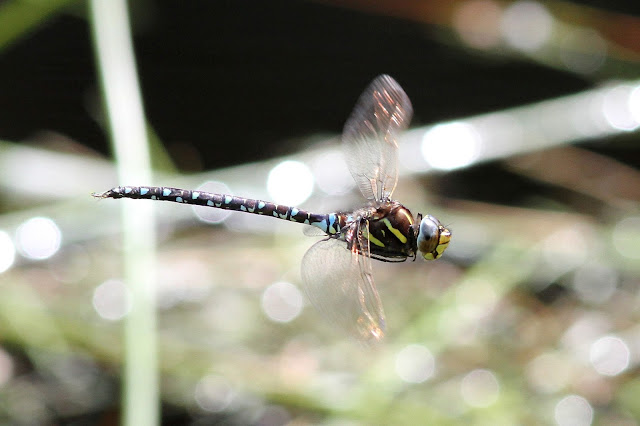Another intruder being let off after accepting a caution.
My Blog List
Wednesday, 31 August 2016
Monday, 29 August 2016
Exuvia
One thing I have yet to witness or photograph is the emergence of a dragonfly. This find represents yet another near miss. It is an exuvia of a hawker dragonfly - the shed exoskeleton of the larva - and comes from either a southern hawker (Aeshna cyanea) or a common hawker (Aeshna juncea). Despite looking it up in the charts I can't be sure which it is and both species are found in this pond. The second photo shows clearly the split in the back of the thorax from which the dragonfly emerged. One of these days I'll strike lucky and see that happening.
Saturday, 27 August 2016
Bird of the week - Cuckoo
This bird was driving me crazy. I made five trips to see it in a week and after the first four I had only three photos to show for ten hours watching and waiting. It was fifth time lucky as I struck gold. I spent almost two hours alone with the bird who was quite unconcerned by my presence although by the end it was wondering which of us was cuckoo.

Everything about this bird is amazing. It never saw its parents who headed off back to Africa in June. It was brought up by foster parents, probably reed warblers or meadow pipits, and then set about feeding itself, choosing the poisonous caterpillars of the cinnabar moth. (The caterpillar absorbs the poison from ragwort, its food plant, but the cuckoo is not affected by the poison.) Within the next couple of weeks or so it will set off to fly to sub-Saharan Africa alone, probably having never seen another of its kind.
The cuckoo (Cuculus canorus) has been in decline in the UK for the last thirty years and is on the red list.
The BTO Bird Atlas abundance map shows that cuckoos avoid London and have a patchy distribution elsewhere.
The decline in numbers has been most evident in England, Wales and southern and central Scotland.
To help to investigate reasons for the cuckoo's decline the BTO has been satellite-tracking cuckoos since 2011. You can read about the project here. This image below shows the migration routes taken by three birds in 2013/14. You won't be surprised to hear that the cuckoo providing the most reliable data was called Chris! The BTO data showed that he spent almost half of the year in the Congo, over a third on migration and only 15% in the UK.
This is Thomas Bewick's painting of an adult cuckoo, an engraving of which appeared in A History of British Birds in 1797.
In Bewick's day the brood parasitism of the cuckoo had only recently been described, in a paper presented to the Royal Society in 1787 by Dr Edward Jenner FRS, perhaps more famous as the pioneer of smallpox vaccination.
You can listen to Sir David Attenborough's BBC Radio 4 Tweet of the Day on the cuckoo here. And watch a video of a young cuckoo being fed by reed warblers after fledging at WWT Slimbridge here.
Friday, 26 August 2016
Wednesday, 24 August 2016
Southern hawker
It has been a good couple of weeks for dragonflies. For comparison with the common hawkers in Monday's post these are male southern hawkers (Aeshna cyanea) in flight. The male has mostly green spots on the abdomen and the blue spots on the last segments are joined. The bright green antehumeral (shoulder) stripes are broad.
The female has similar patterning but is bright green.
Monday, 22 August 2016
Common hawker
This is the common hawker (Aeshna juncea). The two photos above show a male in flight - easy to see but not so easy to photograph. Below is are two males at rest, something they probably do a lot but usually out of (my) view. This afternoon I was lucky.
This is a female at rest. Both sexes have a distinctive yellow costa, the leading edge of the wings.

Here is a female ovipositing at the edge of the pond.
After mating the female lays her eggs alone but runs the risk of being accosted by another amorous male, as happened to this one.
Saturday, 20 August 2016
Bird of the week - Stonechat
The female's colouring is more subtle but no less beautiful.
Here are the two together.
The BTO Bird Atlas shows the stonechat is a bird of the north and west of the British Isles.
The stonechat's scientific name is Saxicola rubicola, meaning rock-dwelling bramble-dweller. Its common name obviously comes from its call, as described by Thomas Bewick in A History of British Birds, although he was hedging his bets.
Bewick also gave its other names of stone-smith and moor-titling.
You can hear the stonechat's call here. And listen to the BBC Radio 4 Tweet of the Day on stonechat here. There is also a BTO video on chats here.
Subscribe to:
Posts (Atom)























































